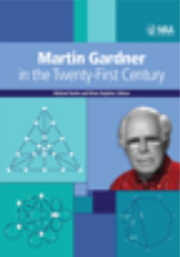Book contents
- Frontmatter
- Preface
- Contents
- I Geometry
- II Number Theory and Graph Theory
- III Flexagons and Catalan Numbers
- IV Making Things Fit
- V Further Puzzles and Games
- 24 Cups and Downs
- 25 30 Years of Bulgarian Solitaire
- 26 Congo Bongo
- 27 Sam Loyd's Courier Problem with Diophantus, Pythagoras, and Martin Gardner
- 28 Retrolife and The Pawns Neighbors
- 29 RATWYT
- VI Cards and Probability
- VII Other Aspects of Martin Gardner
- Index
- About the Editors
24 - Cups and Downs
from V - Further Puzzles and Games
- Frontmatter
- Preface
- Contents
- I Geometry
- II Number Theory and Graph Theory
- III Flexagons and Catalan Numbers
- IV Making Things Fit
- V Further Puzzles and Games
- 24 Cups and Downs
- 25 30 Years of Bulgarian Solitaire
- 26 Congo Bongo
- 27 Sam Loyd's Courier Problem with Diophantus, Pythagoras, and Martin Gardner
- 28 Retrolife and The Pawns Neighbors
- 29 RATWYT
- VI Cards and Probability
- VII Other Aspects of Martin Gardner
- Index
- About the Editors
Summary
Martin Gardner was fond of mathematically-based magic tricks using simple apparatus—in particular, pennies. Chapter 2 of his Mathematical Carnival [2, pages 12–26] is entirely about penny puzzles. About five years later, Gardner and Karl Fulves invented a delightfully simple trick with three pennies (see Demaine [1]). Its explanation involves an important mathematical idea called a state diagram, useful in many combinatorial problems.
A related trick, usually described using cups instead of coins, has the same state diagram with ‘heads’ and ‘tails’ replaced by ‘up’ and ‘down.’ This article explores the relations between the two tricks, develops the deeper mathematics that they have in common, and discusses a generalization of the cups trick. (For other developments from Gardner's penny puzzles, see [1].)
Gardner's three-penny trick
The trick is performed by a blindfolded magician. A volunteer places three pennies in a row, and chooses at will whether each coin shows heads or tails. However, both heads and tails must appear, otherwise the trick ends before it begins. The magician announces that even though she cannot see the coins, she will give instructions to turn coins over so that all three coins show the same face, heads or tails.
The instructions are:
Flip the left-hand coin.
Flip the middle coin.
Flip the left-hand coin.
After steps 1 and 2 the magician asks whether all three coins show the same face, and if the answer is ‘yes’, the trick stops, otherwise the magician requests the third flip.
- Type
- Chapter
- Information
- Martin Gardner in the Twenty-First Century , pp. 181 - 186Publisher: Mathematical Association of AmericaPrint publication year: 2012



